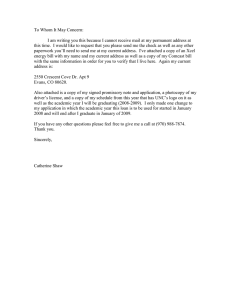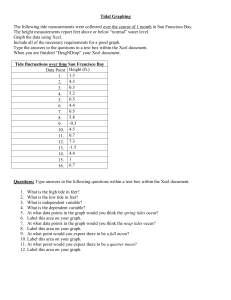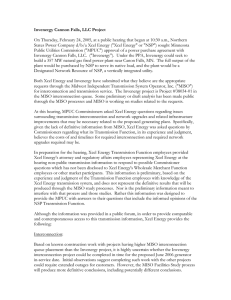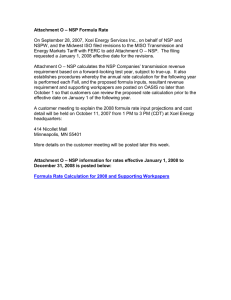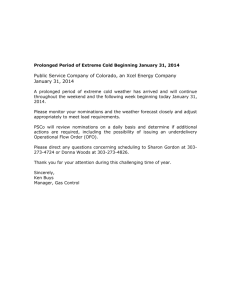October 11, 2007 NSP MISO Attachment O - Meeting Notes
advertisement
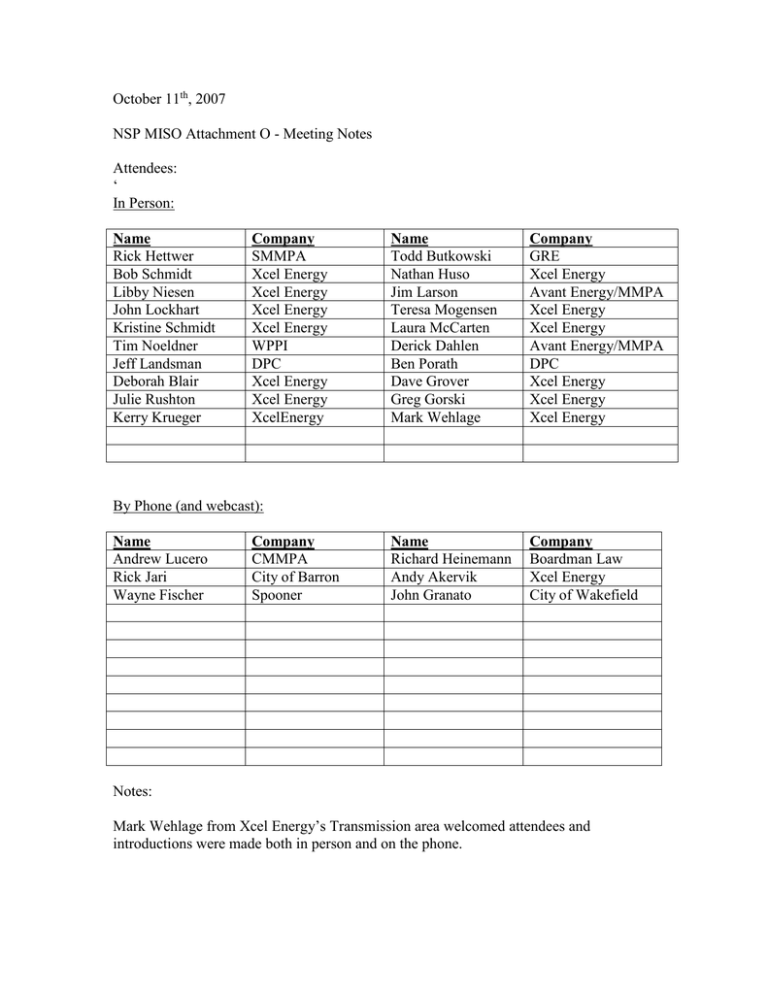
October 11th, 2007 NSP MISO Attachment O - Meeting Notes Attendees: ‘ In Person: Name Rick Hettwer Bob Schmidt Libby Niesen John Lockhart Kristine Schmidt Tim Noeldner Jeff Landsman Deborah Blair Julie Rushton Kerry Krueger Company SMMPA Xcel Energy Xcel Energy Xcel Energy Xcel Energy WPPI DPC Xcel Energy Xcel Energy XcelEnergy Name Todd Butkowski Nathan Huso Jim Larson Teresa Mogensen Laura McCarten Derick Dahlen Ben Porath Dave Grover Greg Gorski Mark Wehlage Company GRE Xcel Energy Avant Energy/MMPA Xcel Energy Xcel Energy Avant Energy/MMPA DPC Xcel Energy Xcel Energy Xcel Energy Name Richard Heinemann Andy Akervik John Granato Company Boardman Law Xcel Energy City of Wakefield By Phone (and webcast): Name Andrew Lucero Rick Jari Wayne Fischer Company CMMPA City of Barron Spooner Notes: Mark Wehlage from Xcel Energy’s Transmission area welcomed attendees and introductions were made both in person and on the phone. Dave Grover, Manager Transmission Regulatory Administration made a presentation detailing some background regarding MISO Attachment O and the recent Xcel Energy FERC filing on behalf of Northern States Power Company MN and WI. Deborah Blair, Director Revenue Analysis made a presentation detailing how formula rates work and the details distinguishing the previous approach used for NSP’s MISO Attachment O versus the new approach proposed in the recent FERC filing made by Xcel Energy. Questions asked by the attendees included: Question: Will there be interest paid on over-collected or under-collected amounts? Answer: Yes, interest will be applied on both under and over collected amounts. Question: Why is Xcel Energy using a 13-month average in rate base? Answer: This approach is consistent with FERC precedent on formula rates. Question: How do you calculate the CWIP balance for the Chisago-Apple River project? Answer: This represents NSP’s 13-months expenditures associated with the Chisago-Apple River project. The CON for the Chisago-Apple River project was assumed in our budget to be approved by the MPUC in February 2008, so therefore the CWIP balance in the formula only has 11 months of balances in the calculation of the 13-month average. Question: When the true-up is calculated, it is effective January 1, 2010? Answer: The true-up for 2008 will be posted on OASIS on June 1, 2009, and will be effective in rates January 1, 2010. Question: Are the Wisconsin wholesale municipal customers currently being billed under a formula rate? Answer: Yes, the customers are billed consistent with the Midwest ISO tariff, which is a formula rate. The new formula uses a projected test-year versus a historic test year. Question: Would Xcel Energy be willing to agree to some sort of set of protocols for review of the inputs into the formula and have an informal basis for asking questions? Answer: Xcel Energy will consider this suggestion. Work papers will be posted every year and annual customer meetings will be held to respond to questions. Question: In your rate you are recovering a CWIP? What is done to ensure these costs are not double collected? Answer: The company will begin tracking pre-funded AFUDC to ensure customers are not charged both AFUDC and a return on the same assets. When the facilities go into service this pre-AFUDC will come through the formula as a credit to rate base to ensure there is no double recovery. Question: Does NSP retail pay the MISO rate for transmission service? Answer: MN customer’s rates are determined by the MN PUC. NSP customers do not get billed by MISO. Question: What is the MN transmission tracker? Answer: In MN there is a transmission tracker for NSP retail customers where these customers pay for CWIP on the same specific transmission projects similar to the way wholesale customers will for CWIP through the MISO formula rate. Question: Xcel Energy is the first Vertically Integrated Transmission Owner in MISO to move to a projected test year formula rate, have you done analysis showing projected test-year will not disadvantage wholesale customers? Answer: Our Midwest ISO rate is calculated in the same way it would be if NSP customers were taking service under the Midwest ISO tariff – Our bundled load is included in the divisor used to calculate the rate. Particularly for new projects, the MN tracker recovers projects on a similar basis for retail customers. When we file a rate case most of the components are the same as are used in calculating the MISO rates. Question: Does CWIP include the regulatory costs NSP is incurring? Answer: In general, CWIP includes construction expenditures, which consist of contract labor, company labor and benefits, materials and supplies, transportation, machine equipment, tool usage, permits, equipment rental, taxes, and various overheads. The initial filing fee paid to the Commission is charged to capital, plus any specific direct billing from the MPUC associated with the CON case. Outside contract labor and internal regulatory labor that relates directly to obtaining the Certificate of Need (CON) can be capitalized and included in CWIP. Question: Does Xcel Energy use remaining life accounting for transmission plant? Answer: The formula rate will include future project abandonment costs that are on the books as CWIP, not projects that will be in service, so the remaining life depreciation method is not relevant. Question: What is included in CWIP? Answer: What we include in CWIP is only the return on CWIP. If a project is abandoned we will be making a filing at FERC to recover the costs we incurred over a specific number of years, a return of costs.
